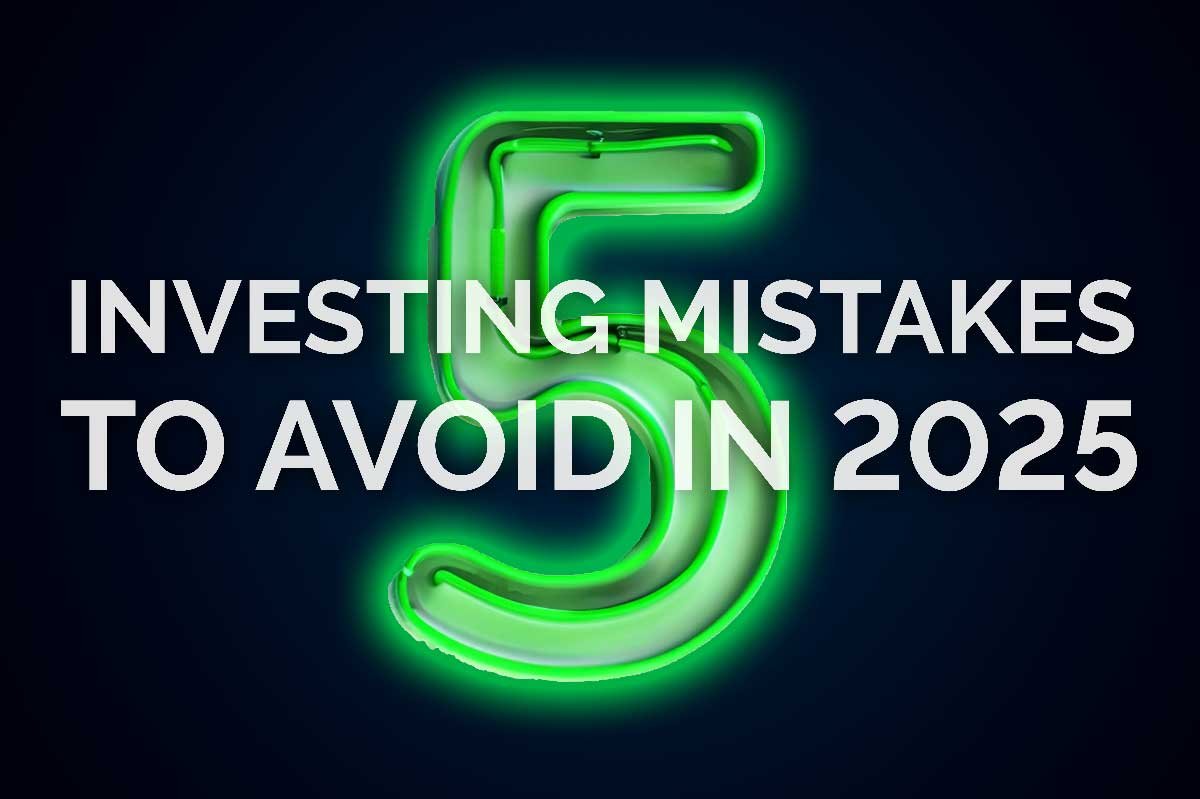The stock market is never boring, and investing mistakes can happen if you take your eye off the ball. In 2024, we experienced impressive gains, sharp declines, and everything in between. From interest rate hikes to inflation concerns and ongoing geopolitical tensions, the year tested even the steadiest investors. While some navigated the turbulence with confidence, many found themselves overwhelmed by the rapid shifts and emotional highs and lows. These challenges highlight the importance of avoiding costly investment mistakes, especially as we head into another uncertain year. If you’re planning your strategy for 2025, staying aware of common pitfalls can make all the difference in achieving your financial goals. Let’s take a closer look at five key mistakes to avoid and how you can safeguard your portfolio against them.
Table of Contents
Mistake #1: Losing Patience in a Volatile Market
Market volatility can feel overwhelming, especially when the ups and downs seem endless. After 2024’s turbulence, it’s no surprise that many investors are feeling on edge. Watching your portfolio take a hit during a downturn—or hearing constant updates about fleeting trends—can push even the most disciplined person to make impulsive decisions. Whether it’s panic selling during a dip or chasing short-term gains during a rally, emotional trading often leads to subpar results. Patience is tough to practice, but it’s one of the most valuable tools an investor can have.
Impact:
- Missed Opportunities: Selling during downturns locks in losses and often keeps you from future recoveries.
- Suboptimal Returns: Buying into trends leads to buying high and selling low, eroding returns.
- Increased Stress: Watching every market twitch can drain you emotionally and physically.
Mitigation Strategies:
- Revisit Your Goals: Focus on your long-term objectives, not the day-to-day noise. Remind yourself why you started investing in the first place.
- Develop a Plan: Create an investment strategy that includes clear rules about risk tolerance, asset allocation, and rebalancing. Stick to it.
- Practice Patience: Remind yourself that market fluctuations are part of the process. Avoid the trap of emotional trading by stepping back and breathing through the noise.
Patience isn’t easy, but it’s essential. Every seasoned investor I’ve spoken to emphasizes the power of staying the course, even when things feel uncertain.
Mistake #2: Neglecting Portfolio Rebalancing
Portfolios don’t maintain their balance on their own. Over time, the performance of different assets causes the weight of each to shift, often leading to unintentional risk. For example, if stocks had a strong year, your portfolio may now be overexposed to equities. Conversely, a poor performance in bonds may leave you underweight in fixed income. This natural drift can throw your portfolio out of alignment with your goals, creating a riskier investment mix than you intended. Rebalancing ensures your investments remain in line with your financial objectives and risk tolerance.
Impact:
- Increased Risk: You may unintentionally expose yourself to too much risk in a downturn.
- Suboptimal Returns: Overweighting poorly performing asset classes can drag down your portfolio.
- Missed Opportunities: Rebalancing allows you to take advantage of lower prices in underperforming areas.
Mitigation Strategies:
- Set a Rebalancing Schedule: Decide how often you’ll rebalance—quarterly, semi-annually, or annually—and stick to it.
- Automate the Process: Many brokerage platforms offer automated rebalancing tools. Use them to simplify the task.
- Be Tax-Smart: Rebalancing may trigger capital gains taxes. Consider offsetting gains with losses (a practice known as tax-loss harvesting).
I’ve found that having a clear rebalancing schedule takes the guesswork out of the process. It also helps me sleep better knowing I’m not overexposed in one area.
Mistake #3: Inadequate Diversification
Diversification is often described as the only free lunch in investing. Yet, many investors still overlook this critical principle, putting too much faith in a single stock, sector, or market. Concentrated investments can lead to significant losses if your chosen bet doesn’t perform as expected. Diversification, on the other hand, spreads risk across multiple areas, increasing your portfolio’s resilience. By ensuring a wide range of investments, you not only reduce your risk but also open up opportunities for growth in areas you might have otherwise missed.
Impact:
- Higher Volatility: Concentrated investments make your portfolio vulnerable to sharp losses if things go south.
- Limited Growth Potential: By ignoring opportunities elsewhere, you limit your portfolio’s upside.
- Reduced Resilience: A narrowly focused portfolio can struggle to recover from unexpected events.
Mitigation Strategies:
- Spread It Out: Invest across asset classes like stocks, bonds, real estate, and commodities to reduce risk.
- Think Globally: Explore international markets to lower reliance on domestic performance.
- Consider ESG Investing: Look into funds that prioritize Environmental, Social, and Governance factors for both diversification and long-term growth.
Here’s a quick checklist to ensure you’re well-diversified:
- Do you have exposure to multiple sectors?
- Are you invested in international markets?
- Does your portfolio include different asset classes?
Remember, diversification doesn’t eliminate risk entirely, but it spreads it out, giving you a better chance to weather storms.
Mistake #4: Ignoring Tax Implications
Taxes might not be the most exciting part of investing, but they can have a massive impact on your returns. Many investors focus on the performance of their portfolio while ignoring the tax implications of their choices—avoid this all-to-common mistake. High capital gains taxes, for example, can eat into your earnings if you’re not careful. On the flip side, overlooking opportunities like tax-loss harvesting could mean missing out on valuable savings. A tax-smart approach to investing helps you keep more of what you earn, maximizing your wealth over time.
Impact:
- Reduced Returns: High capital gains taxes can erode your earnings.
- Suboptimal Choices: Tax concerns might lead you to hold losing investments or make knee-jerk decisions.
Mitigation Strategies:
- Use Tax-Advantaged Accounts: Maximize contributions to accounts like IRAs and 401(k)s to shelter your money from taxes.
- Harvest Tax Losses: Sell underperforming investments to offset capital gains and reduce your tax burden.
- Work with a Pro: A good tax advisor can help you navigate complex tax rules, make smart moves and avoid this common investing mistake
When I started paying closer attention to taxes, I noticed a big difference in my after-tax returns. Even small changes, like rebalancing within a tax-advantaged account, can add up.
Mistake #5: Relying Solely on Media Noise
The 24/7 news cycle has made financial markets more accessible—and more overwhelming—than ever. It’s tempting to follow every headline, stock pick, or expert opinion, but too much information can do more harm than good. Sensational headlines often push investors into making emotional decisions, like buying into hype or selling during a panic. Worse, constant news consumption can distract you from your long-term goals, leaving you chasing trends instead of sticking to your plan. Learning to tune out the noise is a critical skill for any successful investor.
Impact:
- Emotional Decisions: Sensational headlines can push you to buy or sell when it’s not in your best interest.
- Overwhelm: Too much information can leave you paralyzed or make it hard to separate fact from fiction.
- Short-Term Focus: Fixating on daily market moves distracts you from your long-term plan.
Mitigation Strategies:
- Limit News Consumption: Set boundaries around how much financial news you consume each day.
- Prioritize Reliable Sources: Stick to reputable outlets and avoid sensational headlines.
- Stay Objective: Develop critical thinking skills to assess what information is useful and what’s just noise.
I’ve learned to tune out most of the chatter. Want to know my secret weapon against media noise? I focus on what really matters: my financial goals. It’s amazing how freeing it is to stop chasing headlines and start trusting your plan.
In Conclusion: Stay Calm and Stay Focused
Investing is as much about mindset as it is about strategy. By avoiding these five common mistakes, you can keep your emotions in check, focus on your long-term goals, and build a portfolio that stands the test of time.
Key Takeaways:
- Think Long-Term: Avoid short-term reactions and stick to your plan.
- Diversify: Spread your investments across asset classes, sectors, and geographies.
- Rebalance: Regularly adjust your portfolio to stay aligned with your goals.
- Be Tax-Smart: Use tax-efficient strategies to maximize your returns.
- Ignore the Noise: Focus on what matters and tune out unhelpful distractions.
Remember, investing is a journey, not a sprint. By learning from past mistakes and refining your approach, set yourself up for success in 2025 and beyond.
Disclaimer: This content is for informational purposes only and should not be considered financial advice. Always consult with a qualified financial advisor before making investment decisions.


